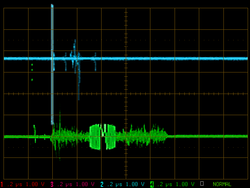Frequency diversity radar
The frequency diversity radar is a radar device in which several different transmission frequencies are broadcast at different times within the duration of a transmission pulse ( English : diversity = variety ).
With this method, it is possible to achieve a significantly higher range with the same detection probability and the same false alarm rate . The physical basis is the smoothing of the fluctuation of the complex echo signal. As a result of the differences in the secondary radiation diagram of the reflecting object for the different carrier frequencies, the extremes (minima and maxima) are shifted from one another, which leads to a smoothing of the resulting signal when the individual signals are added up.
Almost all modern reconnaissance radar devices use this method. For this purpose, the ASR-910 uses (also under the aspect of redundancy ) two separate transmitting / receiving systems that work in the time division multiplex process . The RRP 117 carries out the pulse compression method on two different basic frequencies, which are transmitted one after the other by a transmitter system.
A necessary condition for this range increase by increasing the probability of target recognition is the independence of the reflected individual signals. This is precisely the case when the different spectra of the transmitted and thus the echo signals do not overlap. (The pulse compression method alone does not meet this requirement!)
One advantage of the frequency diversity method is the radar device's higher immunity to interference. Targeted interference must affect both frequencies at the same time before they can take effect. A time-staggered transmission of several signals can also take place by changing the carrier frequency from transmission pulse to transmission pulse. This procedure is called Frequency Agility and is then not primarily aimed at increasing the range, but is only carried out because of greater immunity to active interference (jamming).
